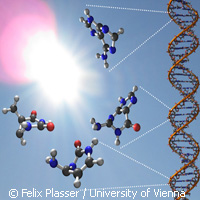Researchers unravel DNA's protection against UV light
The effect of sunlight on our skin often helps people feel healthy and happy, but while tanning may be a desired side effect, it can also initiate damaging processes that lead to serious illnesses such as skin cancer. Researchers in Austria have succeeded in unraveling the shielding mechanisms that allow DNA (deoxyribonucleic acid) to protect itself from the exposure to the UV (ultraviolet) light emitted by the Sun. The results were published in the journal Proceedings of the National Academy of Sciences (PNAS). Scientists led by Hans Lischka, a professor at the University of Vienna's Institute for Theoretical Chemistry in Austria, set out to decipher the ultra-fast processes of the photostability of the nucleobases, without which DNA and RNA (ribonucleic acid) would suffer rapid degradation from UV rays. The researchers said the process under scrutiny was 'simple, yet highly complex', adding that 'as soon as the UV light excites the electrons into a higher energy level, ultra-fast decay brings them back to its original state'. According to them, 'In this way electronic energy is converted into heat.' Despite the complexity of this process, Professor Lischka's team explained that it 'occurs in an incredibly short time dimension, in up to a quadrillionth of a second'. Professor Lischka, together with his colleague Mario Barbatti, now a member of the Max Planck Institut for Coal Research in Germany, and experts from the Czech Academy of Sciences in Prague, created a vivid dynamic picture of the photostability of the nucleobases using innovative computer simulation techniques. They showed how the DNA components - the nucleotides that are responsible in DNA and RNA for the formation of base pairs - protect themselves against decomposition under UV irradiation. The scientists said the main innovation of their study was 'in the detailed calculation of the coupling of the electronic dynamics with that of the atomic nuclei'. They managed to achieve this with the help of worldwide unique quantum chemical methods developed at the Institute for Theoretical Chemistry. 'The calculated states of motion of the nucleobases show a quite remarkable dynamic behavior in time that spans several orders of magnitude,' the team said. The scientists explained that these orders of magnitude went from 'the pico/trillionth to the femto/quadrillionth-second range'. 'Computational effort of these studies was enormous' and hence the results were also only achieved thanks to the extensive use of the combined computer resources of Vienna's academic institutions. The researchers said the newly developed methods could be used for the elucidation of dynamics in DNA nucleobases, and for studies of photo-physical processes in DNA itself and in the area of photovoltaics which is of high technological interest. 'The new methods allow a better understanding of the fundamental processes of transport of electronic excitation energy and of charge separation for production of electricity,' the scientists concluded.
Countries
Austria, Czechia, Germany



